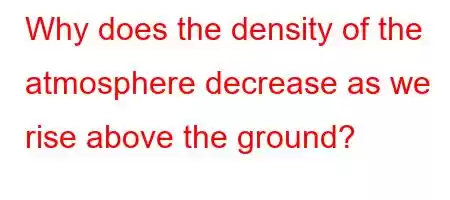Contents: Why does the density of the atmosphere decrease as we rise above the ground?
As the gravitational force decreases with altitude, the density of gases also decreases, and therefore the decrease in air pressure decreases as the rate of decrease increases. ... Since the effect of gravity decreases as you go higher, the distance between the molecules of atmospheric gases is greater. This causes a decrease in density.
How many kg is 1 m3 of air?The density of air is 1,225 kg/m3 under International Standard Atmosphere (ISA) conditions (at sea level, +15°C and 1013.25 mb atmospheric pressure).
Why is the atmosphere thin at the poles and thick at the equator?The temperature of the equator is higher than the poles. As a result of this, rising air is formed at the equator and descending air is formed at the poles due to coldness. Another reason for this is gravity. Gravity is higher at the poles.
In which layer are communication satellites located?Communication satellites are placed in the THERMOSPHERE layer of the atmosphere. In the thermosphere, the sun's rays are very intense.
In which layer of the atmosphere do meteors break apart?Meteors disintegrate in the Mesosphere layer, which is divided into two as Ozonosphere and Chemosphere. The ozonosphere layer is the ozone layer we know and protects the earth from the harmful rays of the sun. The chemosphere layer, on the other hand, allows meteorites to separate into ions and evaporate.
The gaseous layer that protects your world from harmful sunlight is the ozone layer. It decomposes in the mesosphere layer, which is located between the ozone layer and the chemisphere layer. In the chemosphere, meteorites evaporate, separate into ions and disappear.
In which layer do meteorites enter the atmosphere?Answer: Meteors burn and disintegrate between the mesosphere and the stratosphere.
What is the ionosphere, geography?It is the layer where ultraviolet rays break down molecules into ions. It has no obvious effect on climate as gravity decreases. Reflects radio waves Its upper limit is 250 – 300 km above the ground.
Which layer reflects radio waves?Ionosphere layer of the Atmosphere reflects Radio waves. The 70 km to 500 km part of the atmosphere where there are enough ions and free electrons to reflect electromagnetic waves. It is the layer where ultraviolet (ultraviolet) rays break down molecules and turn them into ions.
What is between space and earth?If we consider that the troposphere is between 6-20 km, the stratosphere is between 20-50 km, the mesosphere is between 50-85 and the thermosphere is between 85-690 km, the 100 km limit corresponds to the part of the thermosphere. In other words, between space and Earth are the troposphere, stratosphere, mesosphere and part of the thermosphere.
Read: 193


